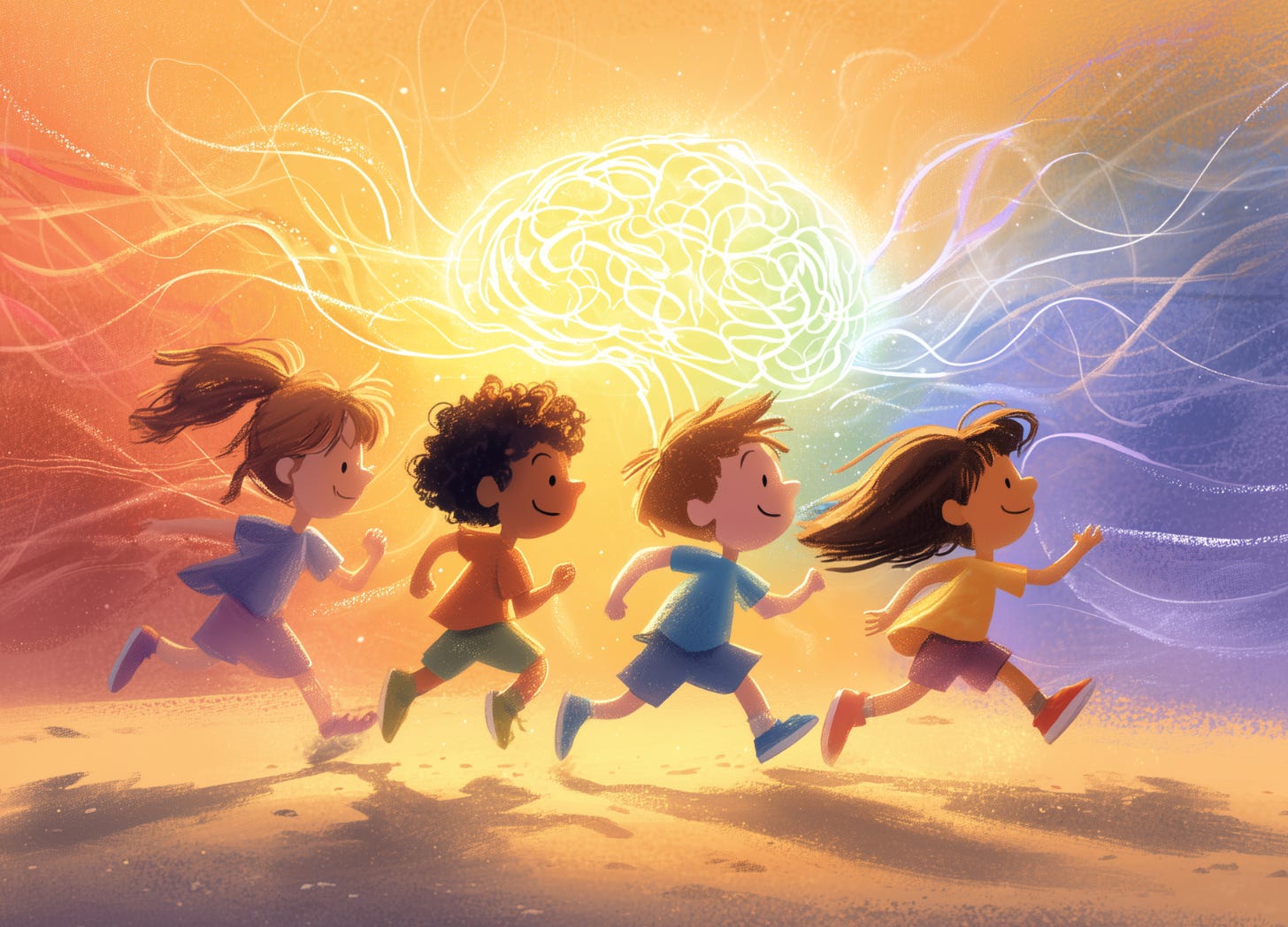Play Is Not Wasted Time. It's Brain Training.
Insights from Neuroscience: how play wires the brain for learning, focus, and resilience
Your child isn’t “just playing.” They’re building the brain skills that shape their future. Blocks become a monster truck, a castle, a dragon’s cave. Monkey bars become a test lab for courage and balance. A single swing jump becomes a 20-minute lesson in focus and persistence.
It looks like fun (and sometimes chaos), but underneath, something serious is happening: play is wiring your child’s brain for learning, self-control, and resilience.
This article is part of our Insights from Neuroscience series. We summarize and highlight what play really does inside the brain — firing reward systems, lowering stress, and strengthening self-control — based on the chapter of “Playing for keeps” from Sandra Aamodt and Sam Wang’s book Welcome to Your Child’s Brain, turning it into practical, parent-ready guidance.
Key Takeaways & Highlighted Insights
Play is universal and essential. From turtles to toddlers, animals play even when it doesn’t serve an immediate survival purpose. This universality suggests play has a deep evolutionary role.
Three main types of play:
Object play: manipulating toys, blocks, sticks, balls — practice for tool use, hunting, building.
Locomotor play: running, leaping, swinging — practice for coordinated movement and agility.
Social play: chasing, wrestling, pretending, role-playing — practice for negotiation, cooperation, and self-control.
Play helps brains grow. By activating reward systems (dopamine) and focus systems (norepinephrine), play wires circuits for motivation, attention, and learning.
Risk is part of the process. Children test boundaries through play, learning what’s safe, what’s not, and how to regulate fear and courage.
Play is practice for real life. Whether it’s squirrel pups chasing or preschoolers pretending to be superheroes, play gives a safe space to rehearse the skills needed for survival, social life, and creativity.
Play builds resilience. More play in animals is linked to survival, lower stress, and better adaptability — the same applies to children.
Play fuels flow and happiness. Deep, immersive play resembles the adult experience of “flow,” a state of joy and creativity that predicts lifelong satisfaction.
Bottom line: play is the work of children. It’s how they experiment, adapt, and discover who they are.
The Neuroscience Behind Play
What looks like “just play” is powered by brain chemistry:
Dopamine: the fun signal
Produced in the substantia nigra and ventral tegmental area.
Makes play feel rewarding—“I want to do it again.”
In animal studies, boosting dopamine increases play; blocking it decreases play.
Norepinephrine: the focus booster
The locus coeruleus provides most of the brain’s norepinephrine.
Helps sharpen attention, mobilize energy, and support learning.
Synapses are more likely to change when norepinephrine is present. Elevated norepinephrine during play helps brain circuits rewire—lessons stick.
Cortisol: the stress hormone
Young squirrels that played had lower cortisol levels.
In bears, cub survival was linked to time spent playing.
Play isn’t just fun—it’s resilience training.
Together, these systems explain why kids naturally seek play. It’s not wasted time—it’s a brain-building necessity.
Practical Tips for Parents
Protect unstructured time. Children need room for free, self-directed play — not every moment should be scheduled or turned into a lesson.
Encourage all types of play:
Object play: keep simple materials around (blocks, cardboard, sticks, art supplies).
Locomotor play: give kids chances to climb, jump, dance, spin, wrestle.
Social play: set up playdates, group games, or family role-play scenarios.
Allow safe risks. Don’t panic over climbing trees, balancing on logs, or jumping from moderate heights. Scrapes and stumbles are part of learning boundaries and resilience.
Notice stress relief. Play is a natural way kids process emotions. If your child is anxious or moody, give them time to play freely before trying to solve the problem.
Value pretend play. Even “silly” scenarios (superheroes, cooking shows, stuffed animal hospitals) strengthen planning, perspective-taking, and self-control.
Look for flow. When your child gets absorbed in an activity — whether it’s drawing, Legos, or imaginative storytelling — that state of deep focus is building happiness and future motivation.
Follow their interests. Your child’s play choices give you clues about what excites them. Support these interests rather than steering them away.
Remember: play is practice, not performance. Resist judging outcomes (the tower’s height, the drawing’s neatness). The value lies in the process, not the product.
Wrapping up
At the end of the day, the blocks will topple, the forts will collapse, and the dragon game will end in giggles. To you, it may look like just another messy afternoon. But to your child’s brain, it’s a master class in focus, self-control, resilience, and creativity.
So the next time you watch your child run, imagine, or wrestle, remember: this isn’t wasted time. This is their work, their practice, their brain growing stronger. Play is not a break from learning. Play is learning. And every time you protect it, you’re giving your child one of the best gifts their brain could ever receive.
If you’d like to support my work with a one-time gesture, thank you so much! Every little bit helps and truly means a lot!



You always provide such insightful reads. Thank you Kunlun. I think with my boy, everything has to be "play"... I feel that I'm in an improv show all day
Thank you for this. I always go back and forth with play. I wonder if I'm letting them play too much. Silly, right? I love the science behind this. Resilience and creativity? Yes please! Sign them up for more unstructured play!!